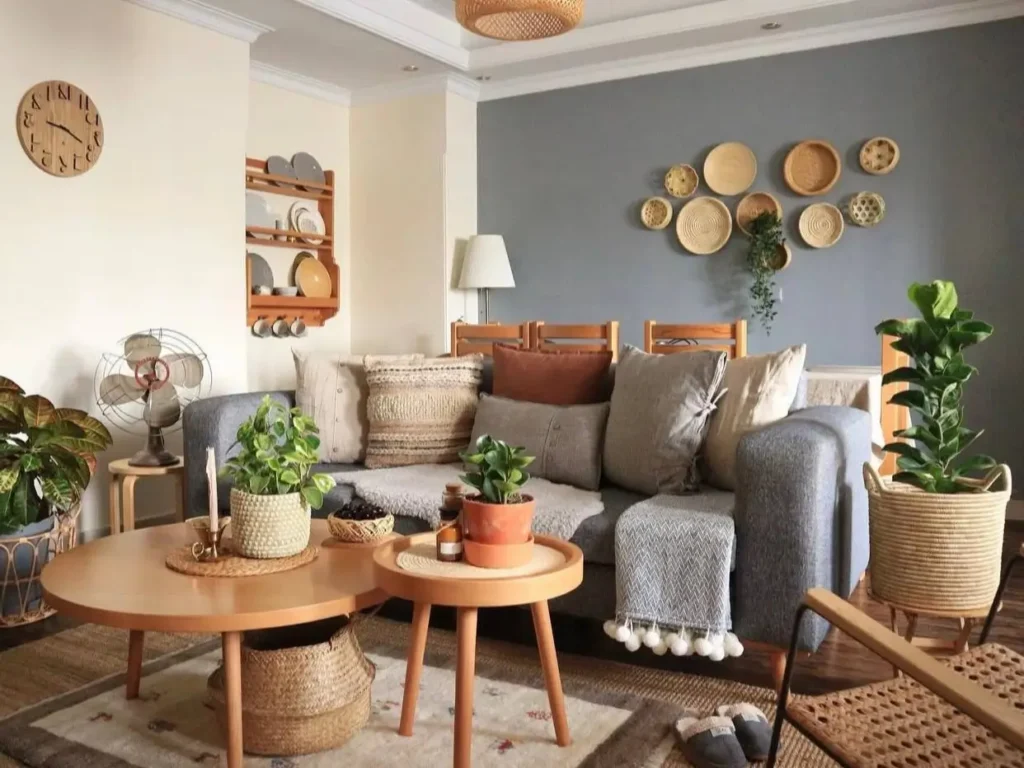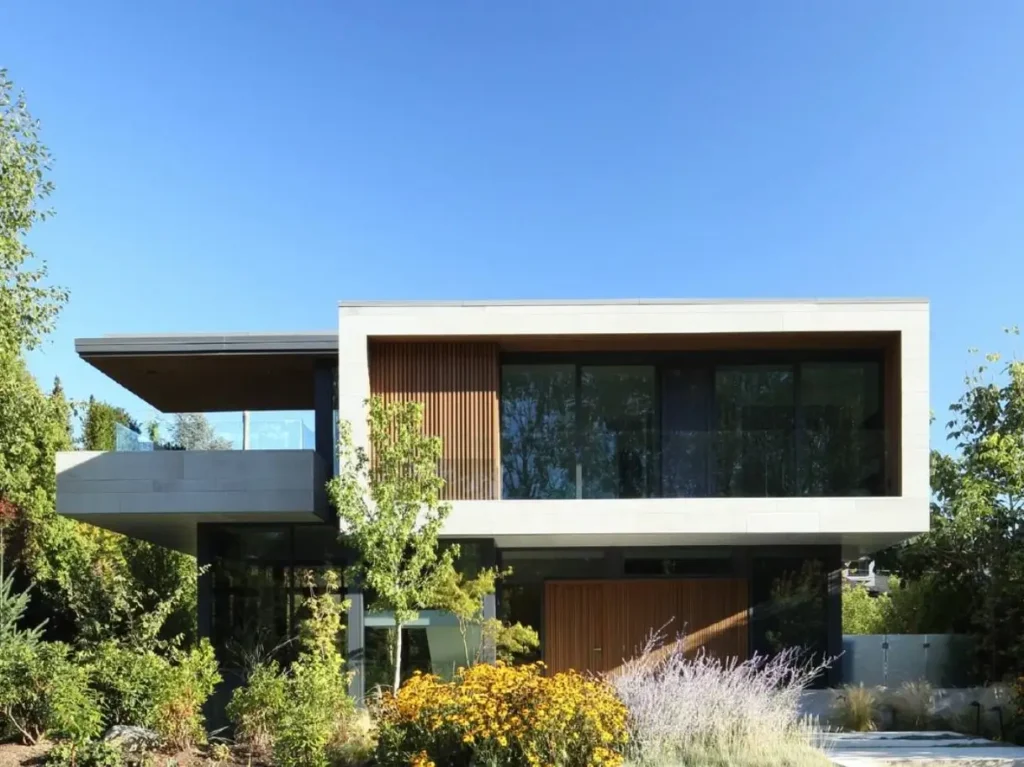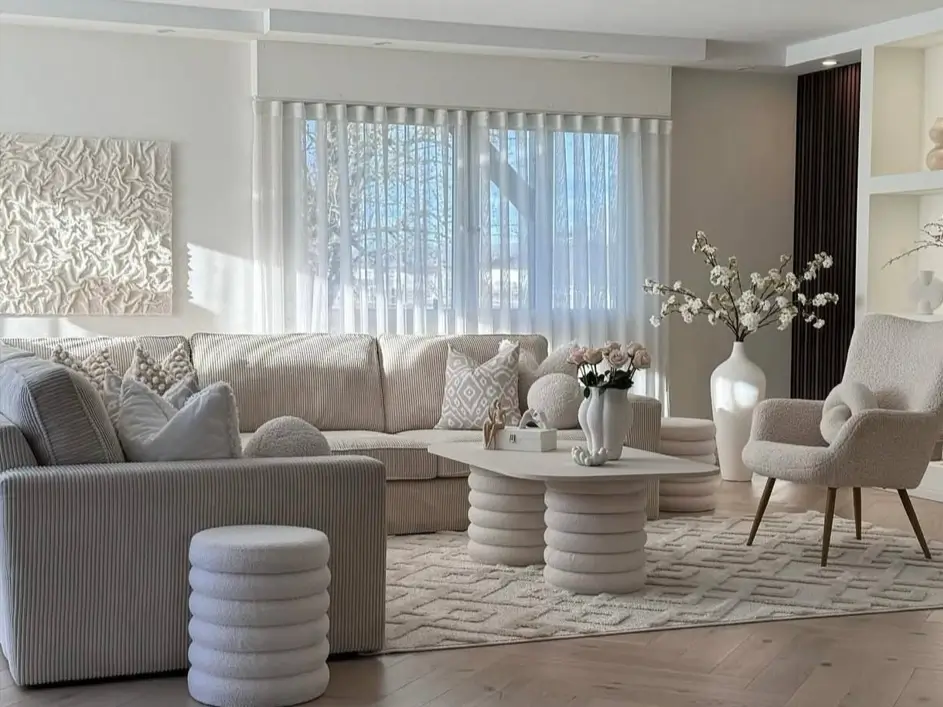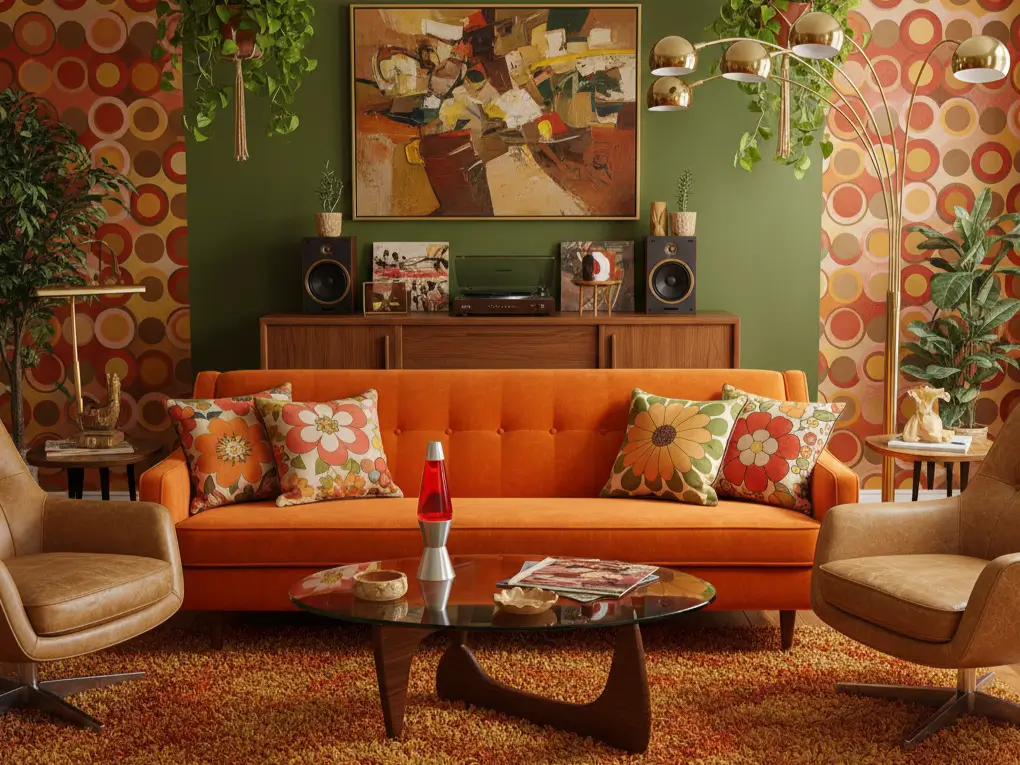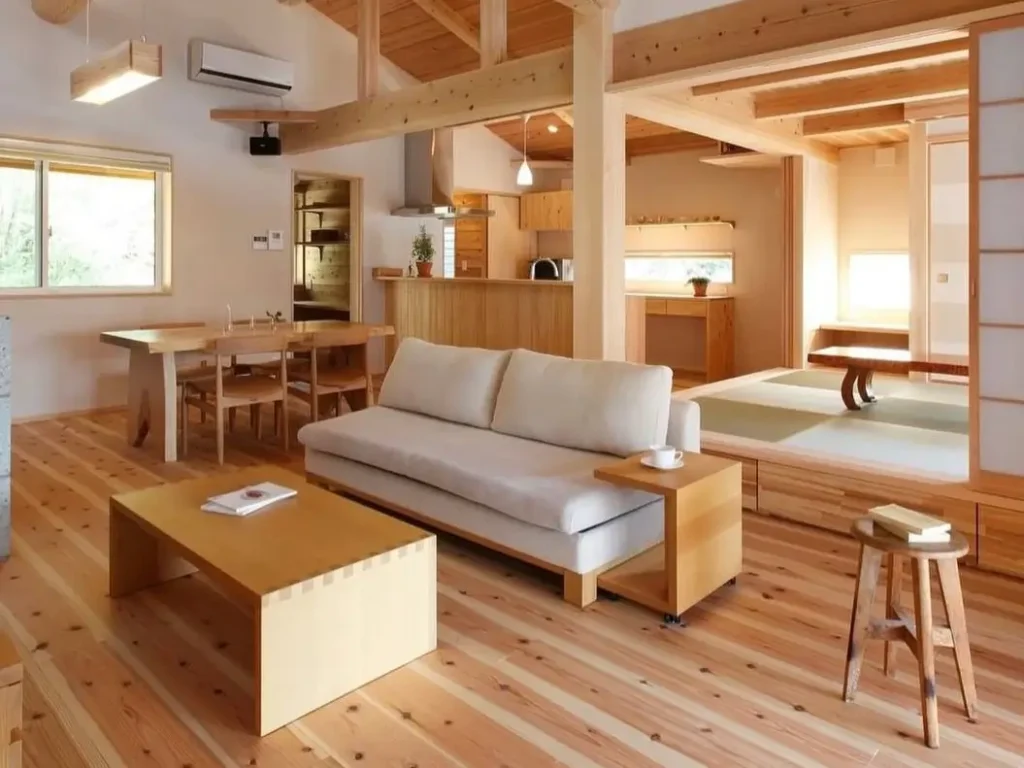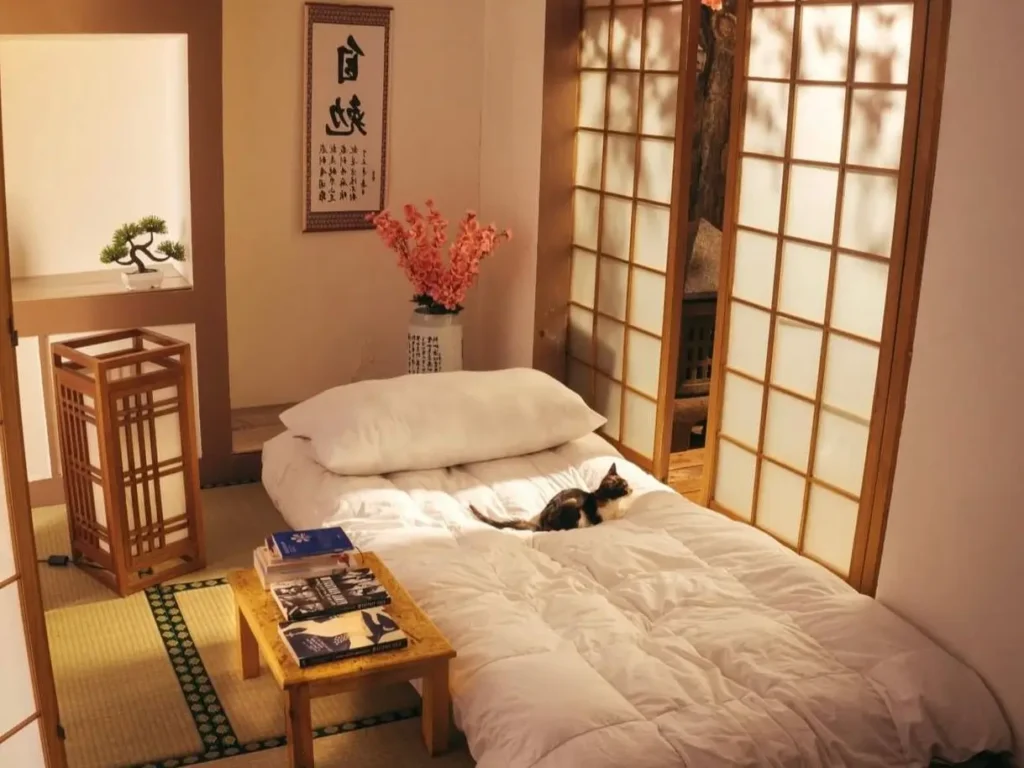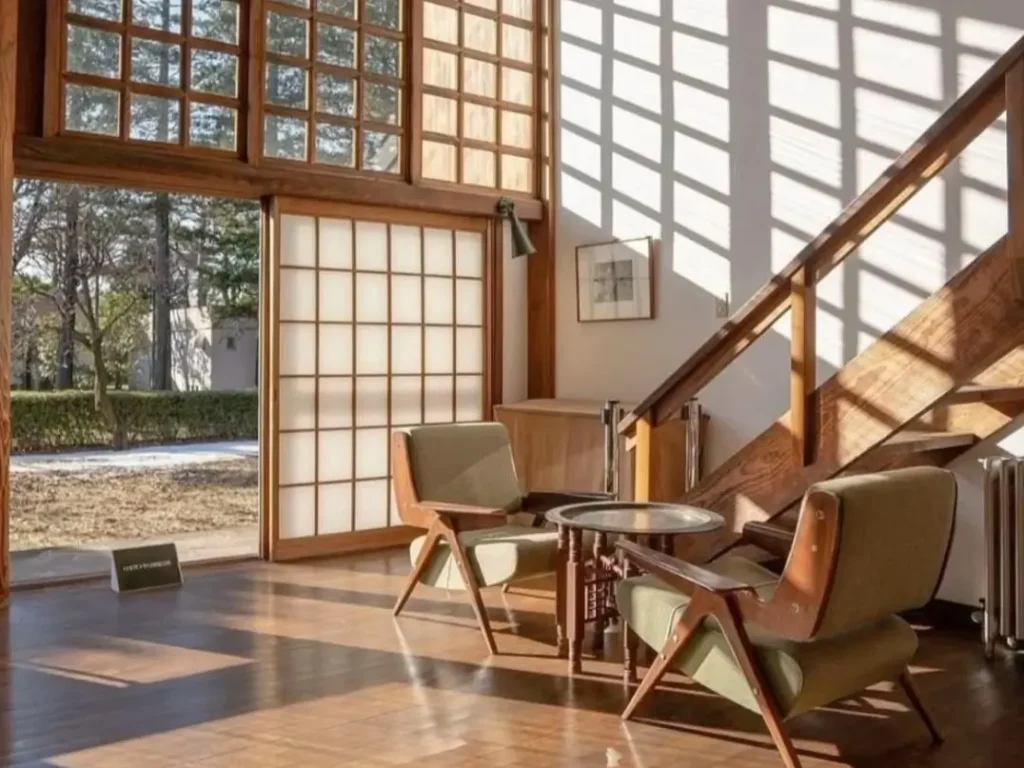A deep-seated harmony with nature, balance, and purpose are the cornerstones of the Japanese aesthetic. This philosophy transforms the living room into a sanctuary, and these core Japanese living room ideas are achieved through thoughtful curation, not stark minimalism.
Exploring Japanese style living room ideas reveals a focus on essentials: maximizing natural light, celebrating organic materials, and maintaining uncluttered surfaces. This curation extends to Japanese living room design ideas, where purposeful placement creates an atmosphere that feels both open and intimate.
The final layer is the Japanese living room decor, where every piece serves a dual role of beauty and function. Get ready to scroll—we’ve compiled compelling examples that illustrate how these principles come together, from traditional tatami rooms to modern Japandi retreats.
The Core Principles of Japanese Living Room Design
Before you dive into the visual inspiration, it’s helpful to understand the principles that inform great Japanese living room design ideas. It’s about more than just aesthetics; it’s about how the space feels and functions. These core concepts are what create the signature sense of calm.
- Celebrate Natural Materials: Wood (like hinoki, maple, or red pine), bamboo, stone, paper, and woven reeds are essential. These elements, which are also vital in a Japanese Kitchen, provide a tangible connection to the natural world.
- Work With an Earthy Palette: Colors are drawn from nature. Think of soft whites, warm beiges, stone grays, and deep browns. Accents often come from plants (green) or textiles (a deep indigo blue).
- Ground the Space With Low Furniture: Traditional Japanese life is centered closer to the floor. This is reflected in low-slung sofas, low tables, and floor cushions (zabuton), which create a grounded, intimate, and open feeling.
- Blur the Line: Inside and Out (Shakkei): The concept of shakkei, or “borrowed scenery,” is vital. Large windows, sliding glass doors, or even a well-placed window to frame a single tree, are used to make the garden or outdoor view part of the room’s design.
- Value ‘Negative Space’ (Ma): This is perhaps the most important principle. Ma is the concept of negative space. The empty, uncluttered areas of the room are just as important as the areas filled with furniture. It is this “emptiness” that allows for clarity, peace, and focus. This is the true heart of Japanese minimalism—the focus on the ’emptiness’ is what gives the few, purposeful items in the room their power and beauty.
- Divide With Light, Not Walls: Traditional shoji screens, made of wood lattice and translucent washi paper, are used to divide spaces. They allow light to pass through, creating a soft glow and maintaining a sense of openness while still providing privacy or separation.
The 34 Definitive Japanese Living Room Ideas
1. Focus on Low Seating
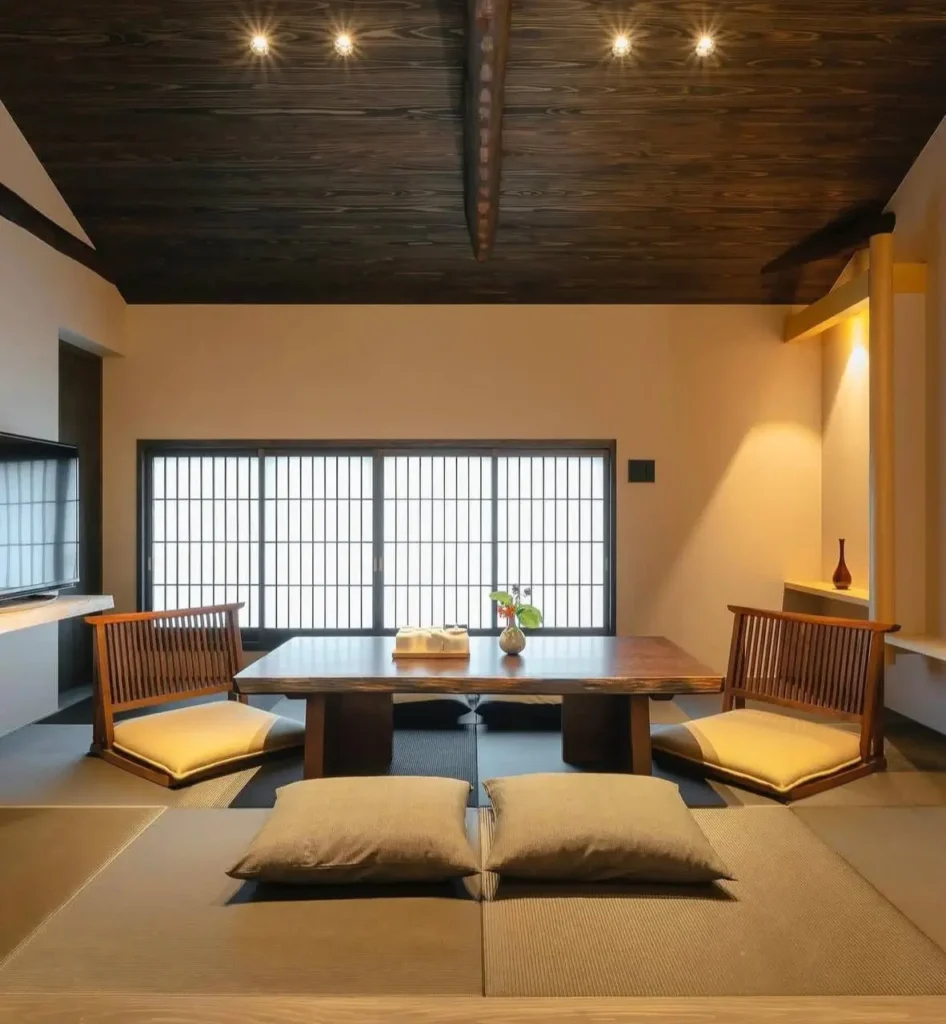
Tatami mats create the foundation for this room. Low-profile zaisu chairs and floor cushions invite a grounded, intimate atmosphere. This setup, paired with a solid wood table, is a classic approach to Japanese living room design ideas, promoting connection and calm.
2. Vaulted Rafters & Light
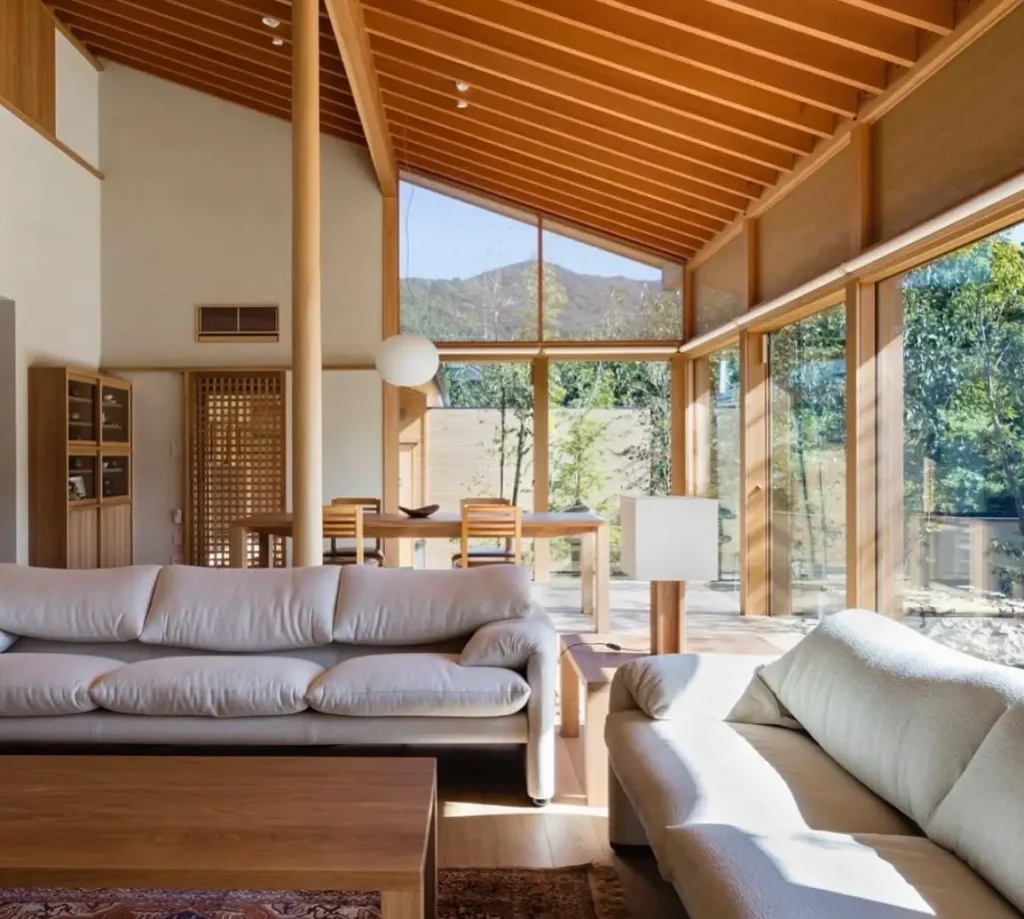
In this space by Takashi Okuno & Associates, exposed rafters create an expansive, high ceiling. This Japanese living room design idea isn’t just visual; the high side windows provide natural gravity ventilation, allowing air to flow. Floor-to-ceiling glass connects the entire room to the outdoors.
3. Introduce Wabi-Sabi

Imperfect surfaces create profound depth. This room pairs a rustic, textured wall with soft, modern furnishings. The raw-edge stone table and dark lattice screen provide an organic counterpoint, a key principle found in Japanese living room decor.
4. Graphic Wall Accent
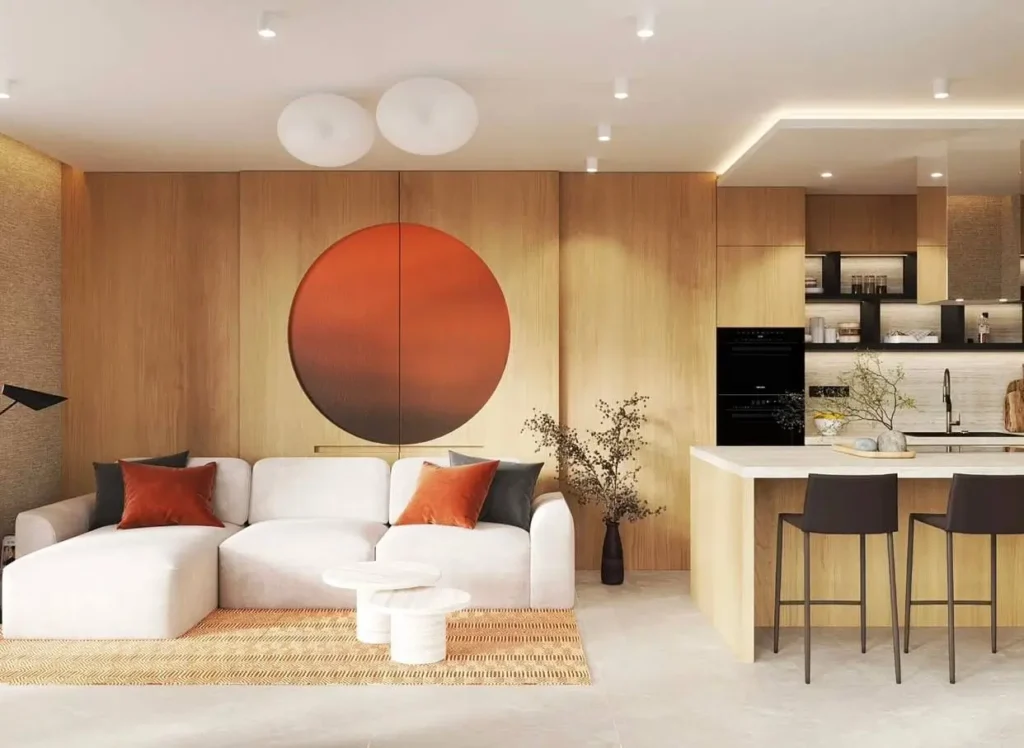
Wood paneling provides a warm, organic backdrop for a striking circular art piece. This bold graphic element acts as the central focus in a modern, open-plan room. The clean lines of the sofa and warm accents create a balanced, contemporary space.
5. Raised Platform Living

Wooden platforms elevate the living space, creating a distinct zone for relaxation or tea. This modern interpretation of a kutsurogi area is a clever Japanese living room idea, defined by wood framing and light-filtering blinds, offering a separate, grounded experience.
6. Crafted Cabinetry & Organic Form
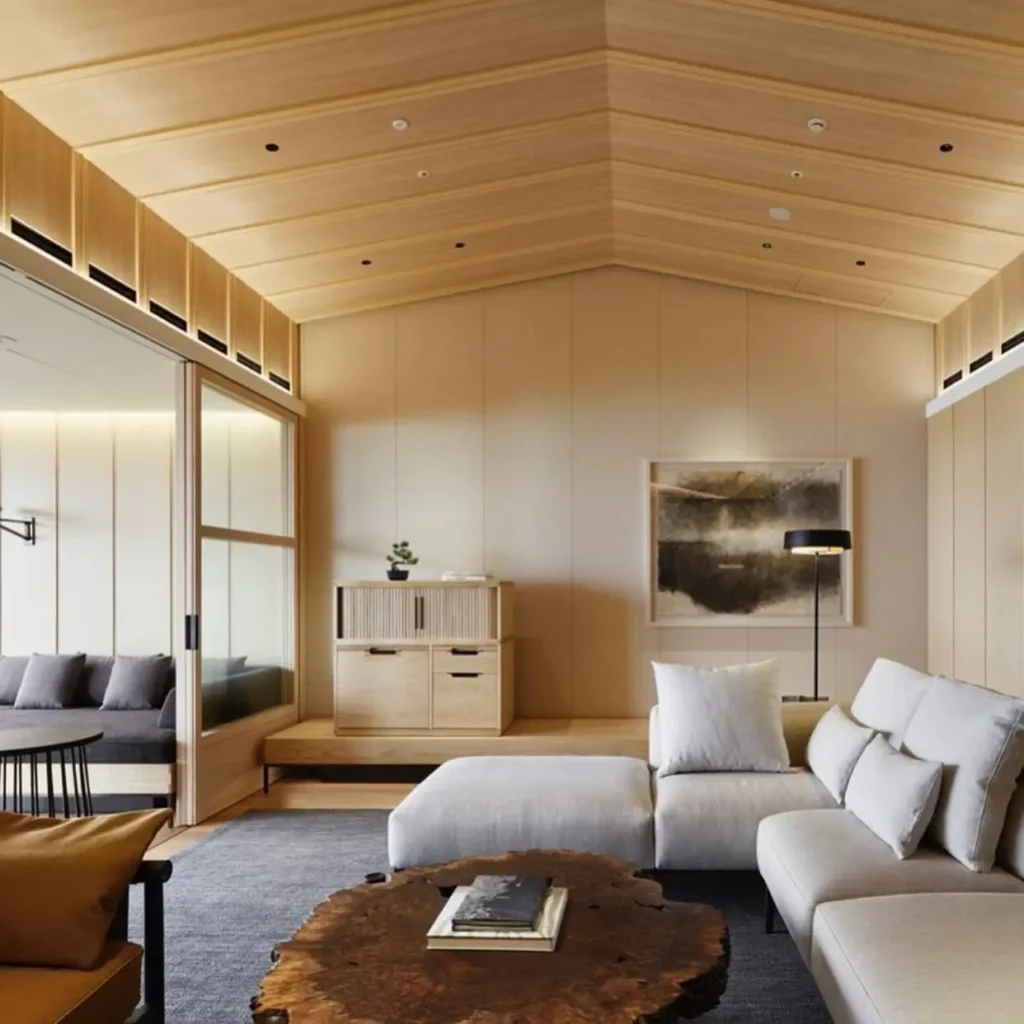
This serene space by Layan Architecture and Nikken Sekkei features a custom minibar based on a traditional Tansu cabinet. This crafted piece, paired with the organic live-edge table, grounds the room with authentic Japanese living room decor and masterful detailing.
7. Moon Gate Frame
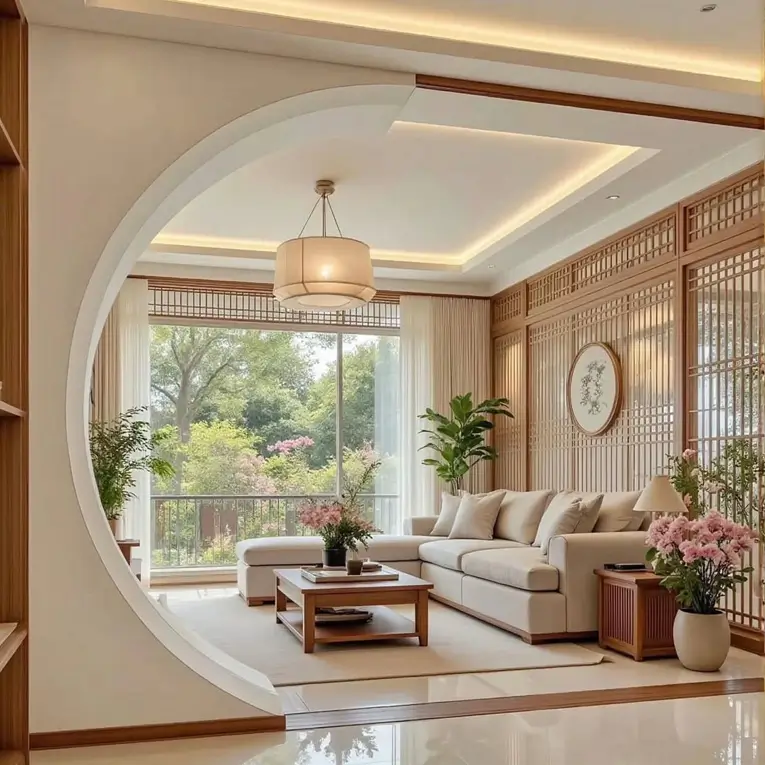
A circular-arched ‘moon gate’ frames the view into this serene room. Intricate wood lattice panels line the walls, balancing the large window’s lush view. This architectural detail adds depth and a traditional element to the modern sectional seating.
8. Dramatic Gridwork

Sunlight filters through an immense lattice window, casting dramatic shadows. This interplay of light and dark becomes the room’s main event. This use of light is a hallmark of Japanese living room decor, balancing the traditional architectural element.
9. High-Contrast Platforms

Dark-stained wood defines a raised platform, creating a dramatic, stage-like seating area. This bold contrast with the light floor and cream sofa is a contemporary interpretation. The grid-pattern window and coffered ceiling add strong geometric structure.
10. Exposed Beam Structure

Exposed dark beams contrast with light wood ceilings, defining this open-plan room. The dining area flows into a low-profile living space, which opens directly via sliding doors to a courtyard garden. This layout seamlessly connects dining, relaxing, and nature.
11. Connect to Nature

Expansive windows and natural materials forge a deep connection to the garden. This room’s vaulted wood ceiling and matching floors create a warm, cohesive shell, allowing the curated, low-profile furniture to complement the outdoor view. This is a core concept for Japanese living room ideas.
12. Horigotatsu Seating

Sunken horigotatsu seating offers the comfort of a modern table within a traditional setting. This room features classic tatami mats, blue zaisu chairs, and sliding shoji screens that open to a small courtyard, blending interior and exterior elements seamlessly.
13. Transitional Veranda Seating

Hardwood floors define this engawa, or transitional veranda space. It bridges the inner tatami room with the outdoors, framed by a wall of gridded, frosted glass. This provides diffused light and privacy, creating a perfect, quiet seating area.
14. Japandi Simplicity
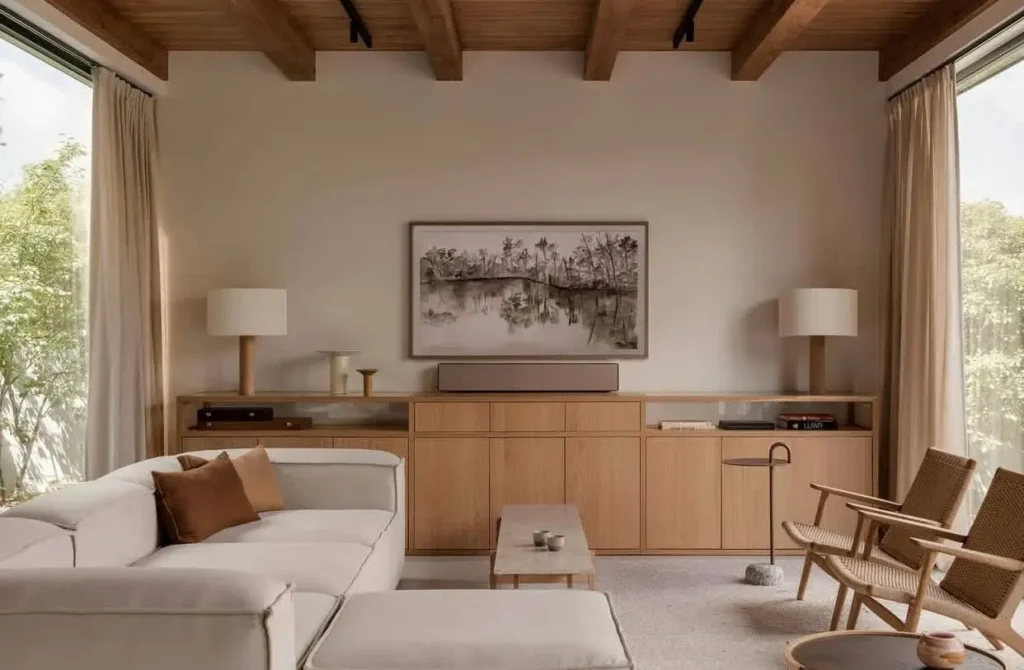
Warm neutrals, natural oak, and clean lines define this Japandi-style room. Exposed ceiling beams add rustic texture, while the low-slung, custom media unit provides ample storage, keeping surfaces uncluttered. This fusion blends Scandinavian function with Japanese calm.
15. Airy, Curated Space

Minimalist principles guide this airy room. Floating shelves display a few curated objects, balancing the sculptural paper pendant. A single branch arrangement adds organic life, while low cabinetry maintains an uncluttered, serene horizontal line.
16. Modern Material Mix
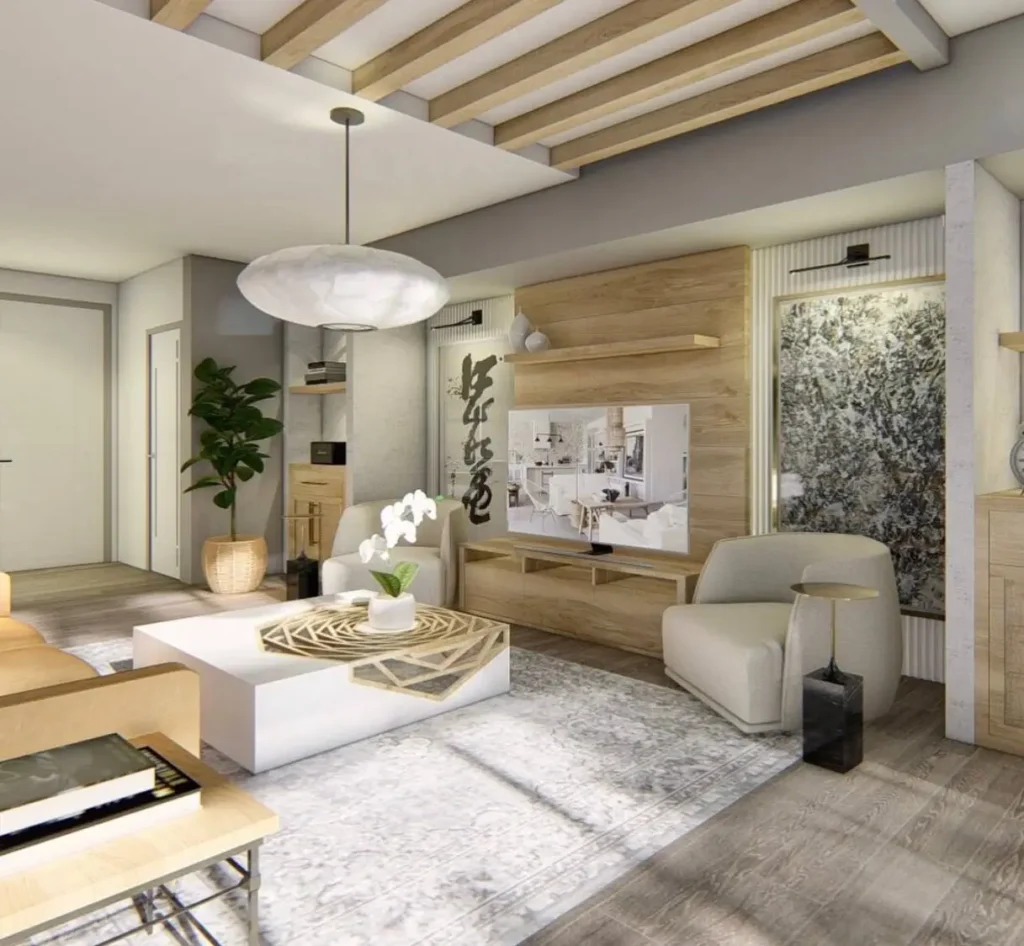
Natural wood, smooth gray panels, and textured stone art create a sophisticated material mix. Light wood beams on the ceiling draw the eye up, adding warmth that balances the modern, blocky furniture. Calligraphy art adds a traditional touch to the contemporary space.
17. Botanical Line Art

Simplicity leads in this tranquil setup. A trio of framed botanical line art provides a gentle focal point without overwhelming the space. The neutral linen sofa, light wood table, and tripod floor lamp create a soft, harmonious, and uncluttered composition.
18. Traditional Tatami Room

Classic tatami mats provide the base for this formal seating area. Zaisu chairs with purple cushions surround a low table, set for tea. An alcove with a curved wall, bamboo accent, and abstract art creates a serene focal point for this Japanese style living room.
19. Courtyard Garden View

Modern comfort meets tradition here. Dark beams and a blue sofa anchor this compact room, while a sliding door reveals a private courtyard garden. Bamboo blinds and a stone lantern complete the tranquil scene.
20. Neutral Textured Layers

Soft, textural layers create warmth in this minimalist space. A bouclé-style sofa, a light wood-framed chair, and a potted olive tree provide gentle visual interest. The abstract bas-relief art adds a sculptural element without introducing color. This use of soft, neutral texture is a key feature of the Japandi fusion style.
21. Bespoke Edo-Inspired Mural

This masterful space by designer Irakli Zaria is directly inspired by an 18th-century Japanese Edo Period screen. The “Wild Grasses” motif flows from the walls onto the curtains, creating a bespoke, immersive Japanese living room design.
22. Curated Artful Corner
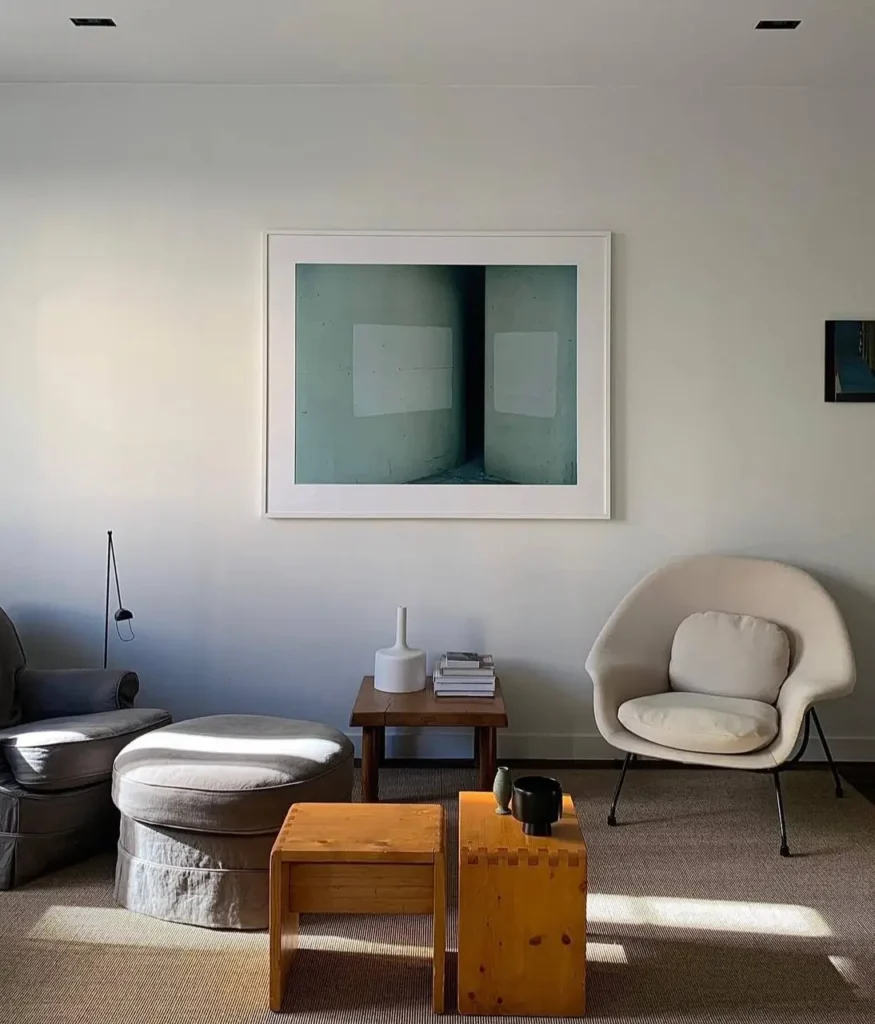
Strong, simple forms define this quiet corner. A sculptural chair is paired with rustic wooden stools, showcasing joinery. The space is anchored by a large, framed art piece, creating a personal, gallery-like feel. This blend of rustic wood and soft, modern forms is a hallmark of the Japandi-inspired aesthetic.
23. Shoji-Inspired Divisions

Translucent shoji-inspired screens serve as a light-filtering wall, separating the living space without blocking light. Paired with a low-profile sofa and a simple, platform-style media unit, the room feels open, organized, and serene. This is a classic example of functional Japanese living room decor.
24. Formal Tatami Room

This traditional washitsu (Japanese-style room) features a tokonoma (alcove) with a hanging scroll, defining the room’s formal center. Carved wooden ranma transoms above the sliding doors allow air to circulate while adding intricate, artistic detail.
25. Vaulted Wood Ceilings
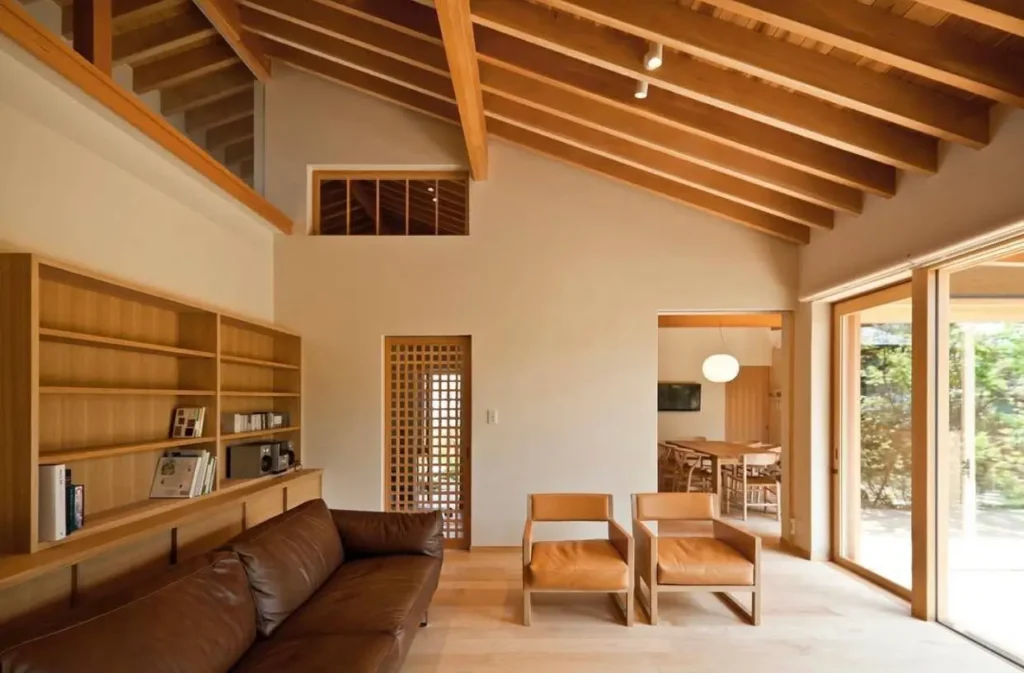
Soaring vaulted ceilings with exposed wood slats create immense volume. Built-in shelving and warm leather furniture provide structure, while a traditional lattice door adds a delicate, architectural detail. The mix of natural wood and open space is a key Japanese living room idea.
26. Deep Veranda Living

A deep, covered veranda extends the living space outdoors, effectively doubling its footprint. The complex vaulted ceiling, crafted from warm wood, continues from inside to out. Clerestory windows high in the gable bring in additional light.
27. The ‘Red Mountain’ Focus

This Moscow living room is defined by its art. The “Red mountain” circular panel, a CGI design by Ksenia Bortsova, is integrated directly into the wood-paneled wall. It’s a masterful focal point that creates a contemporary, art-driven Japanese-inspired living room.
28. The Lived-In Tradition
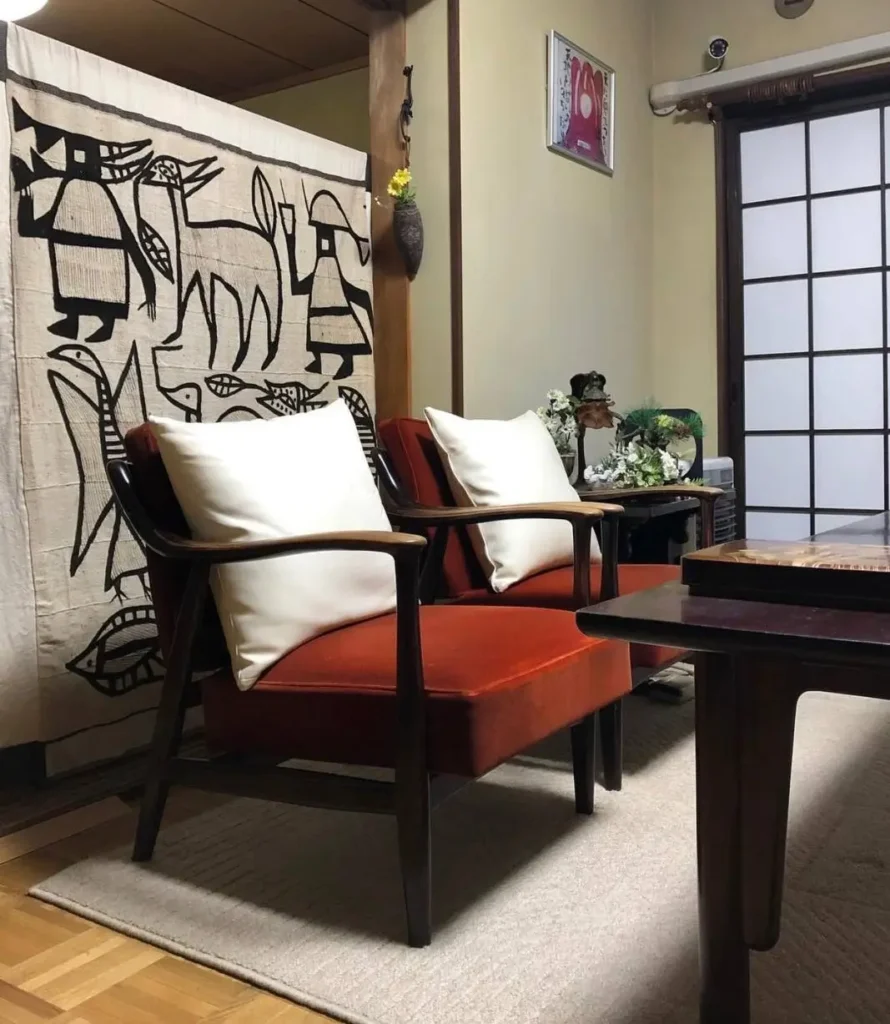
This space, an ‘Obacha’s’ (Grandma’s) house, beautifully represents the “Art of Living” in a traditional Japanese style living room. It’s a space full of spirit, blending daily function with personal art. The handcrafted chairs, upholstered in Japanese velvet, add a layer of modern comfort.
29. Bonsai as Decor
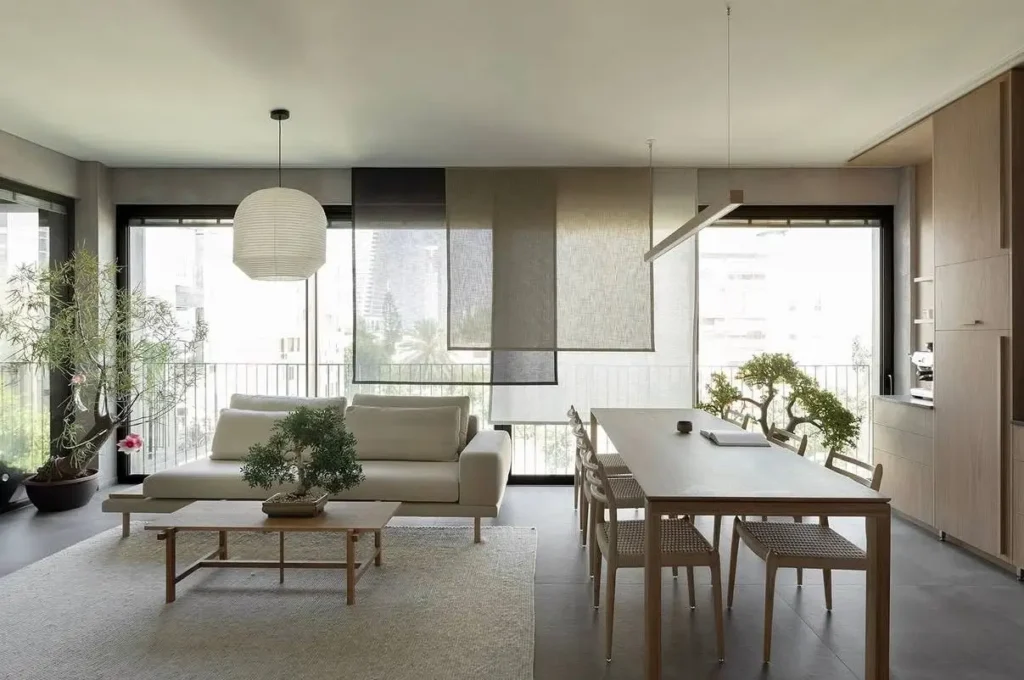
Sculptural bonsai trees serve as living art, placed on the coffee table and by the window. This open-plan space uses a neutral palette, a paper lantern, and layered window shades. This is one of the most iconic Japanese living room decor elements.
30. Curated Global Fusion
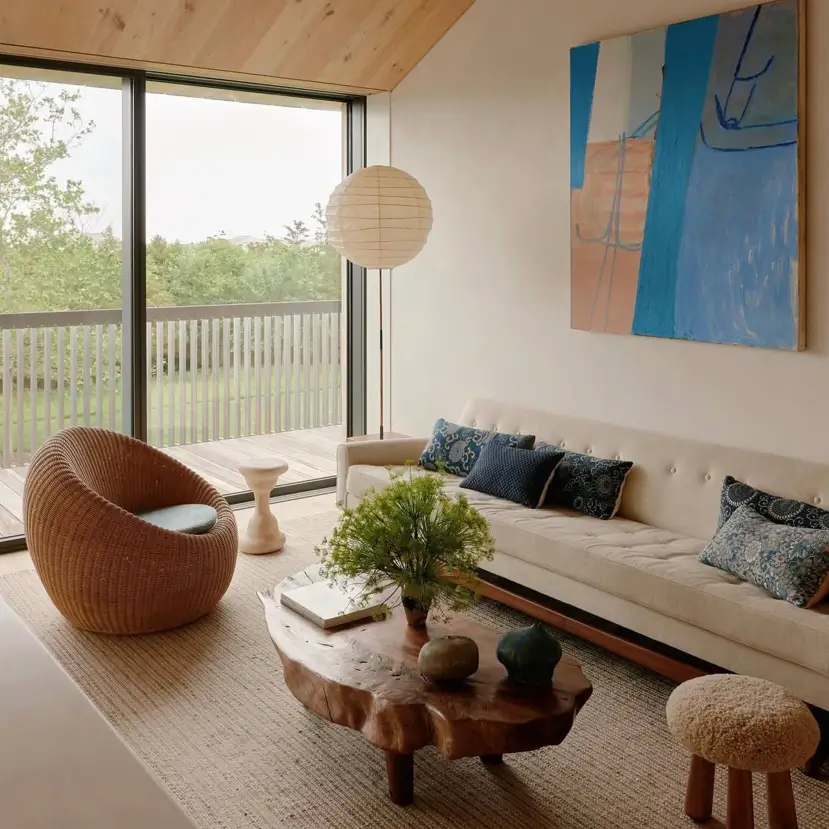
This Wainscott project, designed by Sandra Weingort with architecture by Bates Masi, is a masterclass in global fusion. It intentionally blends Japanese style with Scandinavian, Indonesian, and American touches, using organic forms like the live-edge table to unite art and nature.
31. Historic ‘Suo’ Red

This isn’t just any red; it’s ‘suo’, a deep, historic hue in this traditional machiya house. Used since the 8th century and once reserved for nobility, this rich color provides a dramatic backdrop, changing its expression as the natural light shifts throughout the day.
32. Wood-Framed Furniture
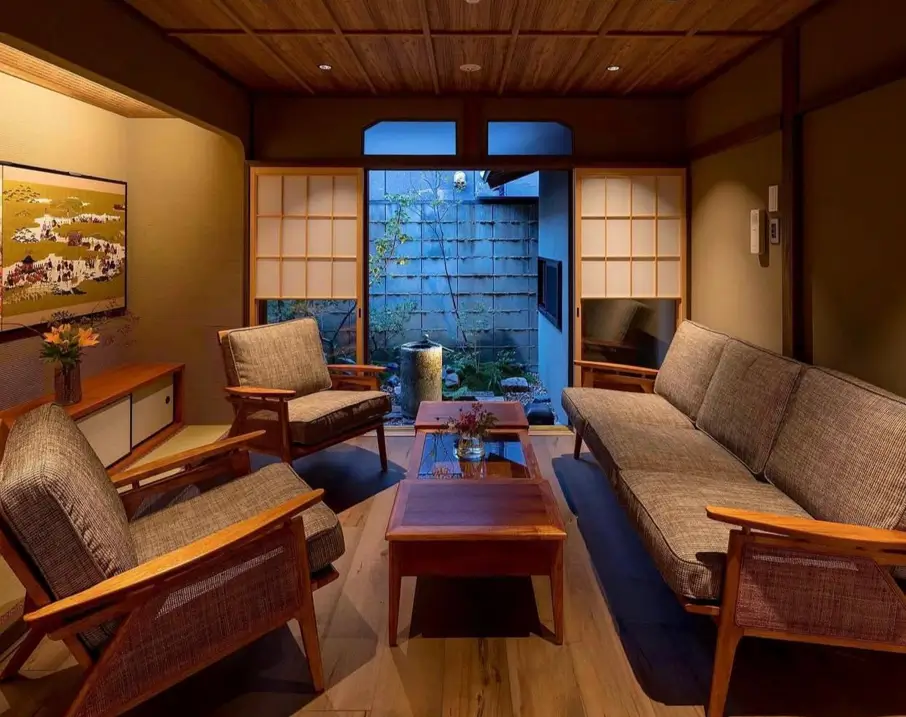
Warmth defines this room, from the coffered wood ceiling to the matching hardwood floors. The mid-century-inspired sofa and armchairs feature exposed wood frames, unifying the space. Shoji screens frame a view to a tranquil inner courtyard, enhancing the calm atmosphere.
33. Modern Tatami Room
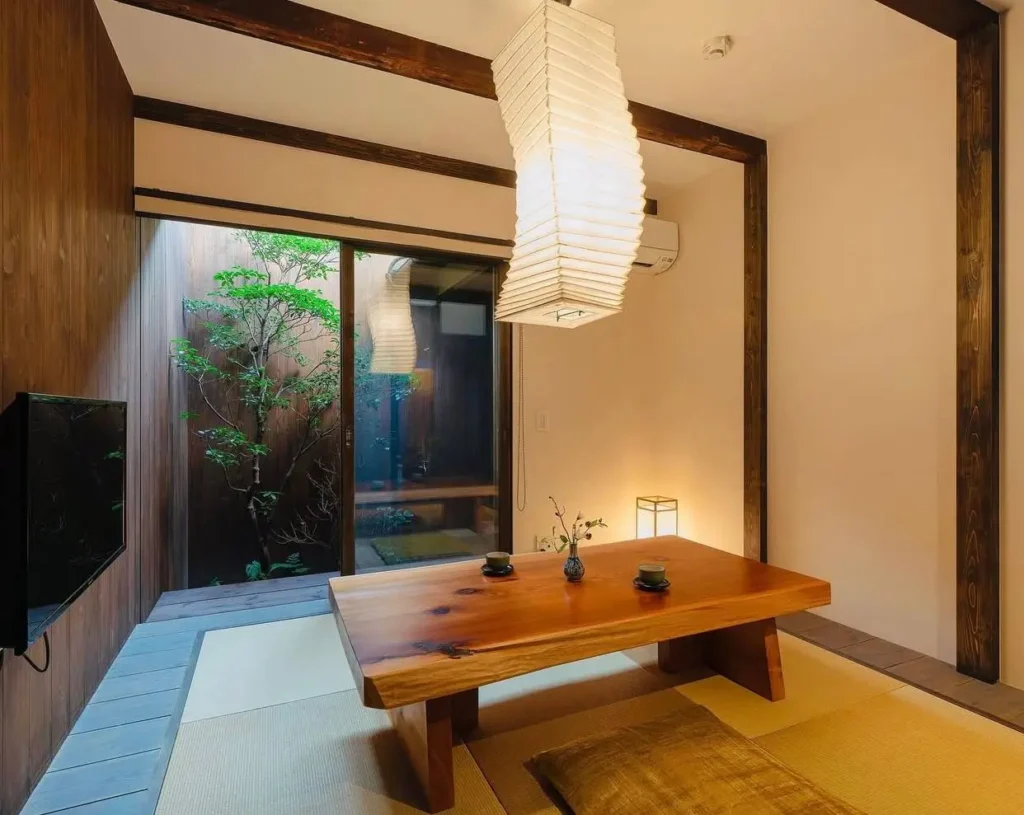
Modern simplicity meets traditional tatami in this calm-space. A thick, live-edge wood table provides an organic centerpiece, illuminated by a sculptural paper lantern. This is one of the most effective Japanese living room ideas for blurring the line between inside and out.
34. Blending Tatami and Hardwood
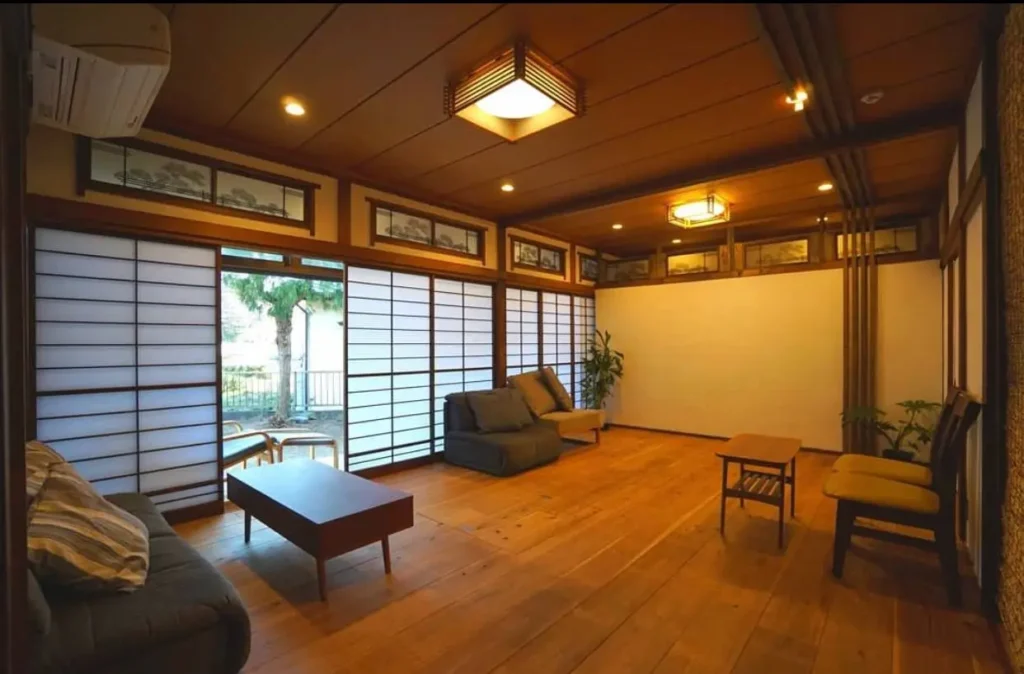
This remodeled room masterfully blends flooring. Tatami mats are set into the hardwood, creating a defined zone for seating. This hybrid approach is a practical, modern Japanese living room idea, adding textural contrast and a clear, meditative focus to the space.
How to Bring Japanese Design Into Your Living Room
Seeing the inspiration is the first step; here is how to start applying these concepts to your own space.
Start by Decluttering (The Concept of Ma)
- The Goal: The most authentic first step isn’t buying new items, but thoughtfully curating what you already own. This aligns with the principle of Ma, or the value of negative space.
- Action: Focus on clear surfaces, ensure every item has a purpose or a “home,” and remove anything that feels purely ornamental and doesn’t bring you joy.
Adapt This for a Small Living Room
- The Goal: The principles of Japanese living room design ideas are ideal for smaller spaces.
- Action: Opt for multifunctional furniture, like a sleek sofa with a futon function or a storage ottoman. Use vertical space with narrow, minimalist shelving. A large, simple mirror can also enhance natural light, making the room feel larger and more open.
Layer Light for a Serene Atmosphere
- The Goal: Avoid a single, harsh overhead light. Layer your lighting to create a mood.
- Action: Use a sculptural paper lantern (like a Noguchi-inspired andon) for a soft, diffused glow. Add a minimalist floor lamp for reading. Consider concealed LED strips behind a media unit or shelf for a subtle, indirect warmth.
Choose the Right Textiles and Textures
- The Goal: A neutral palette needs texture to feel warm and inviting.
- Action: Ground the space with natural fibers. This can be a sisal or jute rug (if you’re not using tatami mats), linen or unbleached cotton curtains, and woven floor cushions (zabuton). These elements add depth and a crucial sense of comfort.
Create a ‘Zone’ for Mindfulness
- The Goal: You don’t need a separate room. A ‘Zen’ corner can be as simple as a single floor cushion (zabuton) and a small plant.
- Action: This creates an intentional space for meditation or simply enjoying a cup of tea, bringing a sense of mindfulness to your home, much like a serene Japanese bathroom.
Frequently Asked Questions
What are the main elements of a Japanese living room?
The main elements for Japanese living room decor include: natural materials (wood, bamboo, stone), a neutral color palette, low-profile furniture (like zaisu chairs or low-slung sofas), and a strong connection to the outdoors. The goal is an uncluttered space, a principle that applies equally to a Japanese bedroom.
How can I create a modern Japanese style living room?
To create a modern Japanese style living room, blend its core principles with modern comforts. Opt for a sleek, low-profile sectional over floor cushions. Integrate natural wood through paneling or furniture. Use minimalist decor, like a single sculptural paper lantern, as a focal point.
What colors are best for a Japanese style living room?
For a Japanese style living room, the palette is typically grounded in nature. Start with soft, neutral colors like white, beige, cream, or light gray. Use natural wood tones for warmth. Accent colors are often deep but natural, such as indigo blue, stone gray, or a muted, earthy red.
What is the difference between Japanese and Japandi style?
Japandi is a popular fusion. It blends the rustic simplicity of Scandinavian design with the minimalist elegance found in many Japanese living room ideas. Think of it as mixing Japanese wabi-sabi (finding beauty in imperfection) with Scandinavian hygge (coziness).
What are some key furniture pieces for a Japanese-style room?
Key pieces to look for include: a low-profile sofa or platform, a simple wooden coffee table (like a chabutai or a modern, live-edge slab), zaisu (floor chairs) or zabuton (cushions), and a minimalist console or tokonoma (alcove) to act as a modern equivalent for a single, curated display.
What is a “Zen” living room?
A “Zen” living room is a Western term for a space inspired by Japanese principles. It emphasizes calm, mindfulness, and simplicity. It uses the same elements—natural materials, a neutral palette, and minimal, uncluttered Japanese living room decor—to create a serene retreat for meditation and relaxation.


